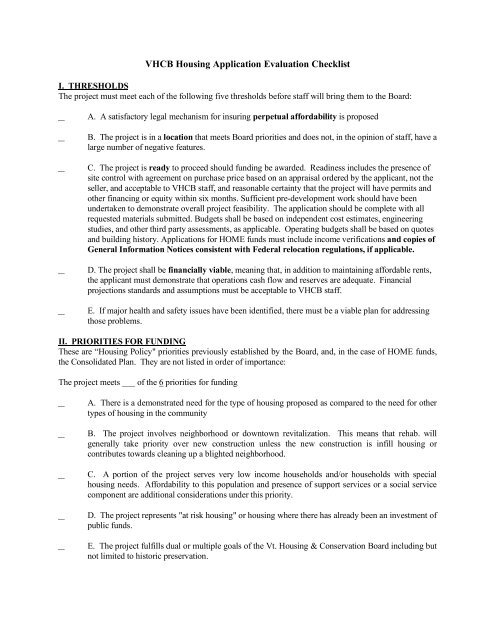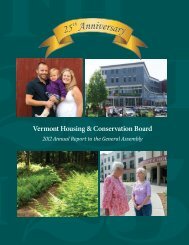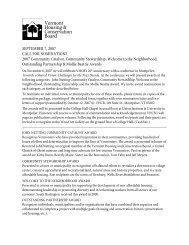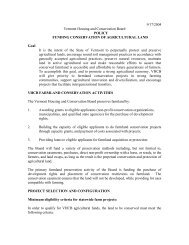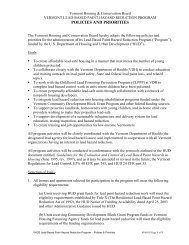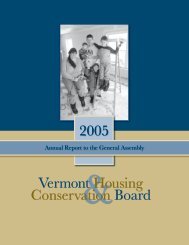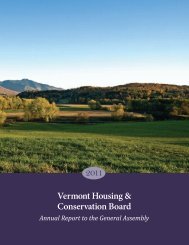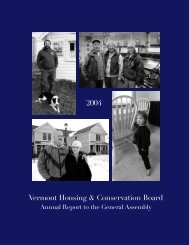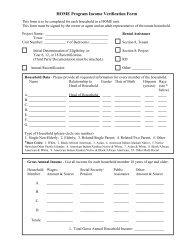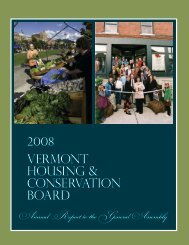Attachment B: VHCB Housing Application Evaluation Checklist
Attachment B: VHCB Housing Application Evaluation Checklist
Attachment B: VHCB Housing Application Evaluation Checklist
You also want an ePaper? Increase the reach of your titles
YUMPU automatically turns print PDFs into web optimized ePapers that Google loves.
<strong>VHCB</strong> <strong>Housing</strong> <strong>Application</strong> <strong>Evaluation</strong> <strong>Checklist</strong><br />
I. THRESHOLDS<br />
The project must meet each of the following five thresholds before staff will bring them to the Board:<br />
A. A satisfactory legal mechanism for insuring perpetual affordability is proposed<br />
B. The project is in a location that meets Board priorities and does not, in the opinion of staff, have a<br />
large number of negative features.<br />
C. The project is ready to proceed should funding be awarded. Readiness includes the presence of<br />
site control with agreement on purchase price based on an appraisal ordered by the applicant, not the<br />
seller, and acceptable to <strong>VHCB</strong> staff, and reasonable certainty that the project will have permits and<br />
other financing or equity within six months. Sufficient pre-development work should have been<br />
undertaken to demonstrate overall project feasibility. The application should be complete with all<br />
requested materials submitted. Budgets shall be based on independent cost estimates, engineering<br />
studies, and other third party assessments, as applicable. Operating budgets shall be based on quotes<br />
and building history. <strong>Application</strong>s for HOME funds must include income verifications and copies of<br />
General Information Notices consistent with Federal relocation regulations, if applicable.<br />
D. The project shall be financially viable, meaning that, in addition to maintaining affordable rents,<br />
the applicant must demonstrate that operations cash flow and reserves are adequate. Financial<br />
projections standards and assumptions must be acceptable to <strong>VHCB</strong> staff.<br />
E. If major health and safety issues have been identified, there must be a viable plan for addressing<br />
those problems.<br />
II. PRIORITIES FOR FUNDING<br />
These are “<strong>Housing</strong> Policy" priorities previously established by the Board, and, in the case of HOME funds,<br />
the Consolidated Plan. They are not listed in order of importance:<br />
The project meets ___ of the 6 priorities for funding<br />
A. There is a demonstrated need for the type of housing proposed as compared to the need for other<br />
types of housing in the community<br />
B. The project involves neighborhood or downtown revitalization. This means that rehab. will<br />
generally take priority over new construction unless the new construction is infill housing or<br />
contributes towards cleaning up a blighted neighborhood.<br />
C. A portion of the project serves very low income households and/or households with special<br />
housing needs. Affordability to this population and presence of support services or a social service<br />
component are additional considerations under this priority.<br />
D. The project represents "at risk housing" or housing where there has already been an investment of<br />
public funds.<br />
E. The project fulfills dual or multiple goals of the Vt. <strong>Housing</strong> & Conservation Board including but<br />
not limited to historic preservation.
F. There are existing identified and severe health or safety threats to lower income households and<br />
the project would correct those conditions.<br />
III. CONTRIBUTING FACTORS OR CONSIDERATIONS (not listed in order of importance):<br />
The project includes ___ of the 17 secondary factors or considerations for funding.<br />
A. Leverage including presence of a bargain sale and amount of request - examined both on a per<br />
unit basis and as percentage of total funds available<br />
B. Services are located convenient to the project or public transportation is available<br />
C. Overall cost effectiveness of product as it relates to quality and value of the product and the<br />
number of other priorities being addressed.<br />
D. Capacity and track record of applicant in housing development.<br />
E. Capacity and track record of applicant in housing management.<br />
F. The project will create or contribute to a mixed income development or community or provide<br />
affordable housing for lower income households in a middle or upper income community<br />
G. Community involvement or support<br />
H. Level of resident involvement in the development and management of the project<br />
I. Livability including but not limited to quality of design and unit layout<br />
J. The project will not cause displacement, especially of lower income households<br />
K. There are other amenities available nearby such as open space or recreation<br />
L. The project is the result of a collaborative effort between different organizations, entities, or<br />
agencies where each party has a different role to perform<br />
M. The project is located in a village area or compact growth center designated by a municipality<br />
where municipal infrastructure such as water and sewerage either exists or will exist in the near<br />
future.<br />
N. The project will result in reduced rent for lower income households and/or failure to undertake<br />
the project will result in loss of equity for mobile home owners or coop members.<br />
O. Project does not negatively impact another <strong>VHCB</strong> goal in a significant fashion<br />
P. Project is consistent with other adopted <strong>VHCB</strong> policies and guidelines<br />
Q. There is a long term plan for stewardship of resource to be used for perpetually affordable<br />
housing


